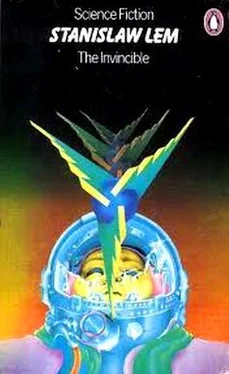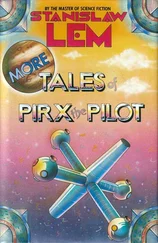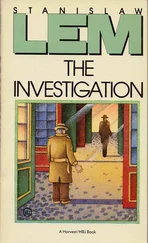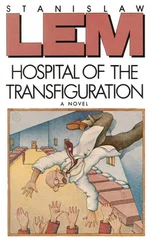It was suggested that atomic battles might have taken place on Regis III among the spaceships escaping their threatened planetary home system. Yet this did not explain the extent of the metalliferous strata, which were discovered in other more remote excavation sites as well. From all these various data a mysterious yet plausible picture emerged: life on the planet’s continents had become extinct during the same span of millions of years during which the metalline deposits had been formed. Radioactivity could not have been the cause of the destruction of all living things. They had made calculations and converted the general amount of radiation into equivalents of nuclear explosions. This amounted to twenty to thirty megatons. Distributed over a period of hundreds of thousands of years, such explosions — if these had in fact been atomic explosions and not some other kind of nuclear reactions — could not, of course, have seriously endangered the evolution of biological forms.
Since the scientists suspected some connection between these deposits and the rains of the “city,” they insisted on continuing with their research, but this required that considerable amounts of debris be cleared away before they could begin prospecting. The only solution was to dig underground shafts; but those who worked below the surface would no longer be able to enjoy the protection of the force fields. The scale was tipped when — at a depth of about twenty yards — a layer rich in iron oxides was found to contain rusty metal parts of a most curious shape that looked like the corroded remnant of tiny mechanisms. At this point the scientists decided to carry on even without the protective energy field.
On the nineteenth day after they had landed on Regis III, dark, dense cloud formations, unlike any they had observed before, gathered over the area where the excavation unit was working. Toward noon a violent thunderstorm broke out that surpassed any electrical storm ever seen on Earth. Sky and mountain merged in the unceasing blinding flashes of lightning. The brooks turned into torrents that rushed down the winding ravines and flooded the excavation site. The men ran for shelter under the dome of the big energy field. Mile-long lightning bolts repeatedly struck the hull of the protective dome. Finally, the thunderstorm moved slowly off to the west, and the entire horizon above the ocean was soon a single black wall ripped by constant lightning.
On the way back to the Invincible the prospecting detail discovered vast numbers of tiny black metal drops in the sand. Were these the ill-famed “flies”? The men gathered them up very cautiously and took them along to the spaceship, where they aroused great interest among the scientists. However, there was no possibility whatsoever that the drops were the remains of insects. Again there were consultations among the experts, frequently resulting in violent controversies. In the end it was decided to send an expedition toward the northeast, beyond the labyrinth of ravines and the areas of iron oxide deposits, because some new discoveries had been made on the caterpillar chains of the Condor vehicles: they had found traces of minerals that had not been seen in any of the terrains that had been examined so far.
The next day, twenty-two men climbed into their vehicles. As soon as sufficient stores of oxygen, food and nuclear fuel had been packed away the column began to move. The group was well equipped with energo-robots, the self-mobile mortar from the Condor, transporters and robots (among them twelve Arctanes), automated dredging machines and rock drills. Regnar was in charge of the expedition. Radio and telvision contact was maintained with the column until the planet’s curved surface made the further use of ultra-short waves impossible. Then the Invincible launched an automatic teleprobe into a stationary orbit, over which communication could be maintained.
All that day the column continued to advance. At nightfall the vehicles and machines formed a defense circle and surrounded themselves with a force field.
The following morning they continued on their way. Toward noon, Regnar informed Rohan that he wanted to stop at the foot of some sand-covered ruins inside a shallow crater in order to inspect them at closer range. One hour later, the reception became very bad because of strong static disturbances. The communication crew switched to another wave length for better reception. Soon afterwards the reception suddenly broke off altogether, just as the thunder died away and the storm moved off into the direction the expedition had taken. The breakdown in communication had been preceded by several episodes of fading that increased in length and strength. Most peculiar, however, was the fact that at the same time TV reception had become worse, even though it was independant of conditions in the ionosphere, as it emanated from a satellite circling beyond the atmosphere. It was about one o’clock when all communication ceased. No technician, none of the physicists called in for consultation, could explain this phenomenon. It was as if a metal wall had descended somewhere in the desert to cut off the expedition from the Invincible.
All this time Rohan had kept close to the astrogator, who seemed quite apprehensive. At first Rohan believed there was no justification for the commander’s attitude. The weather front that had moved off in exactly the same direction as the expedition might have certain definite screening properties. The physicists, however, doubted that such a thick layer of ionized air could possibly come about. When the thunderstorm had completely died down and it was still impossible to re-establish communication, even after sending nonstop call signals, Horpach dispatched two scouting planes of the flying saucer type. It was close to six o’clock in the evening.
One of the flying saucers flew a few hundred yards above the desert. The other rose to an altitude of two and one-half miles, serving as a television transmitter station to its lower flying companion. Rohan, the astrogator, Gralew and a dozen other men, including Ballmin and Sax, stood in front of the big telescreen in the command center, viewing directly whatever happened inside the visual field of the first machine’s pilot. Beyond the dark labyrinth of ravines stretched the desert with its endless chains of dunes, now covered by black stripes, for it was close to sunset. The oblique rays of the setting sun cast the landscape in a mournful light. Small craters, filled to the rim with sand, slipped by underneath the low flying machine from time to time. Some craters had remained visible only because of the central cone of a volcano extinguished for many centuries. The terrain rose gradually and became increasingly diversified. Amid the sandy hills high rocky ridges jutted out, forming an entire system of oddly jagged mountain chains. Lone stone needles resembled the bodies of smashed rockets or of some gigantic figures. Crevices, filled by cone-shaped formations of boulders and rubble, cut the slopes with their sharp outlines. Finally the sand disappeared altogether and gave way to a wilderness of steep rocks and rubble heaps. Here and there tectonic fissures wound through the planet’s crust. From a distance they resembled meandering rivers. The landscape now resembled that on the Earth’s moon. Suddenly the television reception grew worse once again. The image became blurred and synchronization was disrupted. All efforts at correction were in vain.
Now the whitish coloration of the rocks turned into ever darkening shades. The high-rising rocky ridges that moved away from the immediate view were brownish and covered by a poisonous and metallic glitter. Velvety black spots occurred here and there, as if a dense dead scrub proliferated over the bare stones.
Читать дальше











